Our History
How did St John's parish and church come to exist?
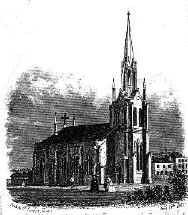
It seems that in the 1830s there was something of a revival in Woodbridge; the population of the country was increasing rapidly and Woodbridge was a significant town with a military barracks and a population of about 5000. St Mary's Church (which dates from the 15th century) was drawing large congregations and in 1839 the church was overflowing with people coming to hear the preaching of the Rev. Henry Hardinge. A project was launched to build a new church in the town and when sufficient money had been raised, the Building Committee advertised for designs for a 'plain and moderately sized' building, to be a daughter church for St Mary's.
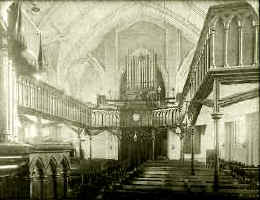
42 designs were submitted! One of them, from the chief builder in Woodbridge at that time, Alfred Lockwood, had as its motto the Bible verse "Except the Lord build the house, they labour in vain that build it". This design was selected, and tenders for construction obtained, again won by Mr Lockwood. However, it is said he made a serious financial loss on the project.
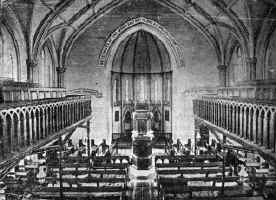
The foundation stone was laid in 1842, unfortunately as part of a grand Masonic ceremony in the town, but we have no such links now. The building then took some years to erect but eventually the white brick building, complete with magnificent spire rising to 138 ft, was complete and ready for its consecration on 27th August 1846. The building was built to seat the surprising number of 800 people, with a gallery extending from the rear along the north and south walls. An organ was situated at the back of the gallery, and the central focus of the apse was a three-decker pulpit. Truly a building for proclaiming the word of God!
The first 100 years (1846 - 1946)
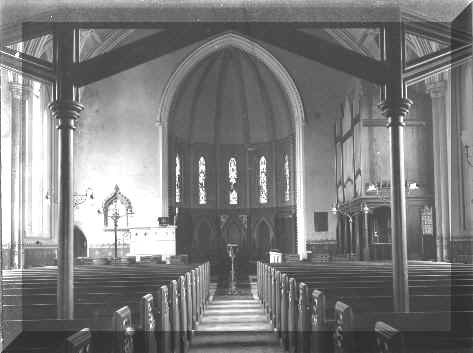
At first the parish was not defined as a separate entity and there was no vicarage for the incumbent, but in 1853 the Parsonage House was built (now known to us as the Old Vicarage), and in 1854 the ecclesiastical parish of St John was formed. From the first the ministries have been definitely evangelical, the benefice being in the patronage of the Church Patronage Society. A religious revival in Woodbridge in 1876 is said to have been largely due to the untiring efforts of the then vicar Rev. Thomas Hyne Edwards.
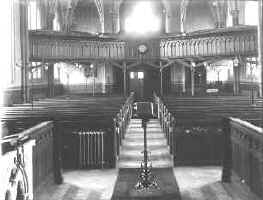
During subsequent years many physical alterations were made to the church building. In 1888 the three-decker pulpit was removed and replaced with a stone pulpit on the north side of the apse and other alterations were made in that area. In 1896 the North and South wings of the gallery were removed, a new organ was installed in the South-East corner of the nave, and the choir moved from the gallery to the chancel facing the new organ. Seating was added in the gallery in the space under the tower formally occupied by the organ.
Up until this time the flooring of the nave had been rough and primitive, and the seating comprised ugly benches and seats nailed together. In 1901-2 the flooring was redone, new teak pews were installed and new leaded windows fitted. Gas was laid on to replace the oil lamps and the interior repainted. Electric light was installed in 1925.
The next half-century (1946 - 1997)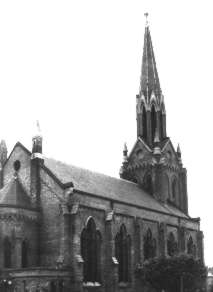
Problems with crumbling of the brick and stonework of the pinnacles of the tower became evident and in 1945 the Diocesan Architect advised that they be lowered to half their original height. In the 1970s serious problems were evident due to the corrosion and expansion of the iron reinforcement of the stonework supporting the spire and, regrettably, the structure was declared unsafe and the spire had to be removed. For some months we worshipped in the Church Hall!
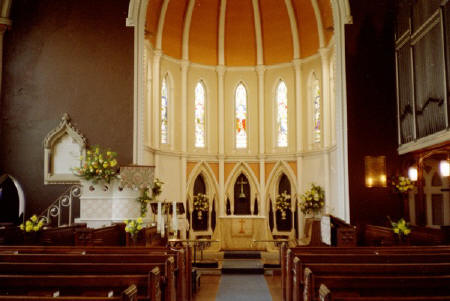
In the 1970s we had a striking colour scheme inside the church; the east wall of the chancel area was dark brown and the apse featured an orange ceiling. When redecoration became necessary in the early 1980s a lighter look was chosen; the dark brown and orange disappeared but the interior furnishings remained a while longer.
Then in 1987-8 major changes were made at the front and the rear of the building. The pulpit and the choir stalls were removed to make way for a raised dais surrounded on three sides by a removable wooden communion rail. A lobby and vestry were added at the main entrance to the building.
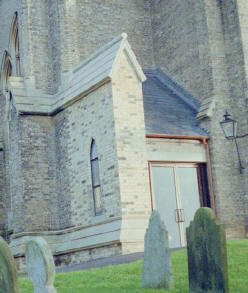
Then in 1997 the most recent phase of internal change was completed with the objective of increasing the flexibility of the building for use in a growing variety of ways, both in worship andappropriate social events. The pipe organ was removed and replaced with a very convincing electronic church organ. The pews were removed, the floor levelled and carpeted, and stackable upholstered chairs introduced. The dais was extended to gain extra space for leading worship. A small servery was constructed under the balcony at one side, and a small vestry under the other. The previous 'new' vestry, added in 1988, became an additional toilet equipped for wheelchair access.
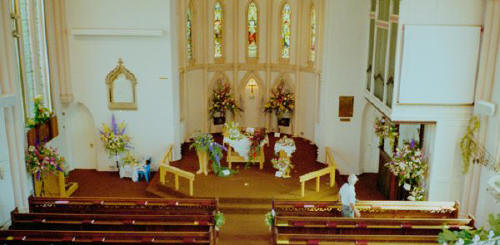
We praise God for the resources that have enabled these changes to be made, and the building which serves us so well. The church is of course the people and not the building, but we pray that the building known as 'St John's Church Woodbridge' will in itself speak to the community of the presence and accessibility of God.
Timeline
-
1842-1846: Church built- cost £3000.
-
1853: Vicarage built - cost £850.
-
1854: Parish formed.
-
Churchyard closed for burials except for those who had purchased ground.
-
1881: 3 decker pulpit replaced with a stone and marble one. Also stone prayer desk and seat.
-
1891: Parish room erected in Vicarage garden, entrance St John's Street. Cost £300.
-
1896: Side galleries removed. Organ installed south-east front of Church.
-
1897: Bell hung
-
1901: Present pews fitted. Church decorated. Gas lights replaced oil and new leaded lights.
-
1913: Clock fitted in tower for the town.
-
1919: Last burial service in churchyard.
-
First PCC election.
-
1925: Electric light installed, cost £50 (replacing gas lights).
-
1929: Choir Vestry built - cost £300. Teak War Memorial tablet erected.
-
1943: Parish room destroyed by fire.
-
1944: Iron railings surrounding churchyard removed.
-
1966-7: Church ceiling replaced and church redecorated.
-
1975: Spire removed because unsafe
-
1982: North gallery staircase removed, and toilet and wash basin put in its place. Church redecorated.
-
1984: New vicarage built, old vicarage bought by the congregation for use as family centre.
-
1985: New electric blower for the organ.
-
1988: choir pews, font, pulpit and brass communion rails removed. New matching wooden table, pulpit, font, clergy desks, choir chairs and communion rails bought. Raised dais built and carpeted. Amplification and recording system fitted. New entrance porch and vicar's vestry built at west end of church. Existing entrance doors replaced by glass panelled doors.
-
1994: Full-time Youth Leader appointed
-
1996: Church Hall interior extensively renovated
-
1996: Plans to reorder the interior of St John's
-
1997: Pipe organ and pews removed and replaced with digital electronic organ and chairs. Dais and communion rails extended. Dais, nave and gallery recarpeted. New vestry, servery and disabled WC built. New PA system installed.
-
2002: New spire added to church building.
-
2010: Major repairs to Old Vicarage roof and chimneys.
-
2014: Major external repairs to high parts of church building, particularly to the north and west.
-
2015: Complete internal redecoration of the church building.
Clergy
-
1846-1871: Revd J M Rowley
-
1871-1881: Revd T H Edwards
-
1881-1919: Revd C B Ratcliffe
-
1919-1923: Revd P M Hinde
-
1923-1946: Revd T G Rhind-Tutt
-
1946-1953: Revd R Tydeman
-
1954-1963: Revd H Hodge
-
1964-1968: Revd E T N Jarvis
-
1968-1973: Revd D Parsons
-
1974-1985: Revd R G Speck
-
1985-1991: Revd P H Miller
-
1992-1998: Revd R F Webb
-
1998-2012: Revd D G Gardner
-
2013-2021: Revd C Howard
-
2022 Revd C Trefusis